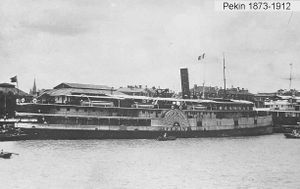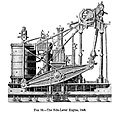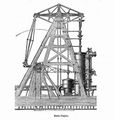Pekin
Sister ship to Hankow and Shanghai
Contents
History
1873. The builders, A.& J.Inglis, installed the "American walking" beam style of engine, so named as the pitch and throw of of the beam arms gave the illusion of walking legs. The local Chinese called them "Walkee-walkee boats". Two side lever, single cylinder engines were connected to the driving cranks, which in turn were connected to the "American" beam. ( N.B. In the days when this type of engine was built, each cylinder and its attendant piston rods, valve and shaft was considered to be a complete engine, even though they were permanently coupled together.) The paddles operated as a pair, the main paddle shaft being connected to the other end of the beam. The Pekin could operate on one boiler and one cylinder, and was the first of a class of four vessels for the lower Yangtse operations. The Pekin was delivered to China Navigation Co. in July 1873 and placed in service on the lower reaches of the Yangtse river. This class of vessels employed on the lower Yangtse were of shallow draught, flat bottomed with no keel, were equipped with twin large spade rudders to assist in manoevering. Cargo was man-handled through side hatches. As this propulsion design was becoming outdated by the more efficient compound engine driving a propeller, Scott & Co. became the major ship builder for The China Navigation Co.
July 1912. The vessel was withdrawn from service, converted to a hulk / accommodation vessel and used at Wuhu. It was still in use in 1937.
Service
1904. Employed on the Shanghai - Ningpo service, departing Shanghai on Monday, Wednesday and Friday, and returning from Ningpo on Tuesday, Thursday and Saturday.
Events / Stories
On one photograph the name on the paddle box is "Peking". This is possibly an error on the part of the builder, A & J Inglis, which was later corrected, as at this time there were no vessels registered as "Peking". Other photographs show the name on the paddle box as "Pekin" which is the name under which the ship was registered. The photographs all indicate the same vessel.






